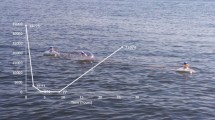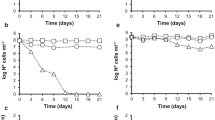Abstract
To verify the hypothesis of cryptic growth and viable but nonculturable (VBNC) state, survival responses of Escherichiacoli cells were examined under oligotrophic microcosm conditions for an extended period. In the case of filtered distilled water at 4°C, E. coli cells definitely entered the VBNC state within 56 days. However, culturability and viability increased while the total number of cells declined after 110 days. This phenomenon can be explained by considering three possible states. The first is the existence of the VBNC state, the second is cryptic growth, and the third is the death of E. coli cells. In the case of artificial seawater at 4°C, VBNC E. coli cells confirmed the existence of two log units of elongated VBNC cells. Moreover, elongated VBNC cells showed the most significant change among all the other transformed cells. Also, E. coli cells in microcosms at 28°C indicated the entrance to the classical starvation survival state. In resuscitation tests, 1% diluted Luria-Bertani agar medium showed the highest level of resuscitation among amended agar media. To evaluate the survival ability of E. coli cells in the activated sludge samples, we used an E. colistrain XL-1 blue containing plasmids pQ2 including GFPcDNA (XL/GFP). In supernatant of activated sludge (SUP) at 28°C, XL/GFP cells entered the VBNC state after 10 days, whereas existence of VBNC cells was not detectable in resuspended activated sludge (ACT) at 28°C.



Similar content being viewed by others
References
Bloomfield SF, Stewart GS, Dodd CE, Booth IR, Power EG (1998) The viable but non-culturable phenomenon explained? Microbiology 144:1–3
Bogosian G, Sammons LE, Morris PJL, O’neil JP, Heitkamp MA, Weber DB (1996) Death of the Escherichia coli K-12 Strain W3110 in soil and water. Appl Environ Microbiol 62:4114–4120
Bullock WO, Fernandez JM, Short JM (1987) XL1-blue: a high efficiency plasmid transforming recA Escherichia coli strain with beta-galactosidase selection. Biotechniques 5:376–378
Cappelier JM, Minet J, Magras C, Colwell RR, Federighi M (1999) Recovery in embryonated eggs of viable but nonculturable Campylobacter jejuni cells and maintenance of ability to adhere to HeLa cells after resuscitation. Appl Environ Microbiol 65:5154–5157
Caterina S, Maria ML, Pietro C (2001) Modification of the peptidoglycan of Escherichia coli in the viable but nonculturable state. Curr Microbiol 44:125–131
Chalfie M, Tu Y, Euskirchen G, Ward WW, Prasher DC (1994) Green fluorescent protein as a marker for gene expression. Science 263:802–805
Hobbie JE, Daley RJ, Jasper S (1977) Use of nuclepore filters for counting bacterial by fluorescence microscopy. Appl Environ Microbiol 33:1225–1228
Hugo A. MM, Guadalupe V, John O, Channah MR, Debanjana D, Kevin HO, Geoffrey BS (2003) Optimization of a reusable hollow-fiber ultrafilter for simultaneous concentration of enteric bacteria, protozoa, and viruses from water. Appl Environ Microbiol 69:4098–4102
Jansson JK (1995) Tracking genetically engineered microorganisms in nature. Curr Opin Biotechnol 6:275–283
Kogure K, Ikemoto E (1997) Wide occurrence of enterohemorrhagic Escherichia coli O157:H7 in natural fresh water. Nippon Saikingaku Zasshi 52:601–607
Kogure K, Simidu U, Taga N (1978) A tentative direct microscopic method for counting living marine bacteria. Can J Microbiol 25:415–420
Leo E, Renate S, Aldo A, Otto G, Robert E, Claus S, Soren M, Rudolf A (1997) Use of green fluorescent protein as a marker for ecological studies of activated sludge communities. FEMS Microbiol Lett 149:77–83
Lowder M, Unge A, Maraha N, Jansson JK, Swiggett J, Oliver JD (2000) Effect of starvation and the viable-but-nonculturable state on green fluorescent protein (GFP) fluorescence in GFP-tagged Pseudomonas fluorescence A506. Appl Environ Microbiol 66:3160–3165
Mizunoe Y, Wai SN, Takade A, Yoshida SI (1999) Restoration of culturability of starvation-stressed and low-temperature-stressed Escherichia coli O157 cells by using H2O2-degrading compounds. Arch Microbiol 172:63–67
Mizunoe Y, Wai SN, Ishikwwa T, Takade A, Yoshida SI (2000) Resuscitation of viable but nonculturable cells of Vibrio parahaemolyticus induced at low temperature under starvation. FEMS Microbiol Lett 186:115–120
Morono Y, Takano S, Miyanaga K, Tanji Y, Unno H, Hori K (2004) Application of glutaraldehyde for the staining of esterase-active cells with carboxyfluorescein diacetate. Biotechnol Lett 26:379–383
Oliver JD, Nilsson L, Kjelleberg S (1991) Formation of nonculturable Vibrio vulnificus cells and its relationship to the starvation state. Appl Environ Microbiol 57:2640–2644
Prasher DC, Eckenrode VK, Ward WW, Prendergast FG, Cormier MJ (1992) Primary structure of the Aequorea victoria green fluorescent protein. Gene 111:229–233
Ravel J, Knight IT, Monahan CI, Hill RT, Colwell RR (1995) Temperature-induced recovery of Vibrio cholerae from the viable but nonculturable state: growth or resuscitation? Microbiology 141:377–383
Reasoner DJ, Geldreich EE (1985) A new medium for the enumeration and subculture of bacteria from potable water. Appl Environ Microbiol 49:1–7
Rollins DM, Colwell RR (1986) Viable but nonculturable stage of Campylobacter jejuni and its role in survival in the natural aquatic environment. Appl Environ Microbiol 53:531–538
Rozak DB, Grimes DJ, Colwell RR (1984) Viable but nonrecoverable stage of Salmonella enteritidis in auatis system. Can J Microbiol 30:334–338
Ryan FJ (1959) Bacterial mutation in a stationary phase and the question of cell turnover. J Gen Microbiol 21:530–549
Smith JJ, Howington JP, Mcfeters GA (1994) Survival, physiological response, and recovery of enteric bacteria exposed to a polar marine environment. Appl Environ Microbiol 60:2977–2984
Tanji Y, Furukawa C, Na SH, Hijikata T, Miyanaga K, Unno H (2004) Escherichia coli detection by GFP-labeled lysozyme-inactivated T4 bacteriophage. J Biotechnol 114:11–20
Tombolini R, Unge A, Davey ME, Bruijn FJ, Jansson JK (1997) Flow cytometric and microscopic analysis of GFP-tagged Pseudomonas fluorescens bacteria. FEMS Microbiol Ecol 22:17–28
Unge A, Tombolini R, Molbak L, Jansson JK (1999) Simultaneous monitoring of cell number and metabolic activity of specific bacterial populations with a dual gfp-luxAB marker system. Appl Environ Microbiol 65:813–821
Wai SN, Mizunoe Y, Takade A, Yoshida SI (2000) A comparison of solid and liquid media for resuscitation of starvation- and low-temperature-induced nonculturable cells of Aeromona hydrophila. Arch Microbiol 173:307–310
Weichart D, Oliver JD, Kjelleberg S (1992) Low temperature induced non-culturability and killing of Vibrio vulnificus. FEMS Microbiol Lett 100:205–210
William GR, Mary PL, David ND (1988) Restoration of colony forming activity in osmotically stressed Escherichia coli by betaine. Appl Environ Microbiol 54:3142–3146
Acknowledgements
This research was financially supported by a grant from the Japanese Ministry of Education, Environmental Protection Board, Science, and Technology.
Author information
Authors and Affiliations
Corresponding author
Rights and permissions
About this article
Cite this article
Na, S.H., Miyanaga, K., Unno, H. et al. The survival response of Escherichia coli K12 in a natural environment. Appl Microbiol Biotechnol 72, 386–392 (2006). https://doi.org/10.1007/s00253-005-0268-3
Received:
Revised:
Accepted:
Published:
Issue Date:
DOI: https://doi.org/10.1007/s00253-005-0268-3




